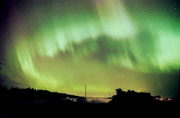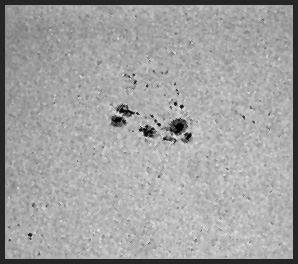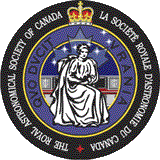A ROARAing
Through the Night
by Sandy Barta
 Image by Eric Schandall
Image by Eric Schandall
The daytime sky is clear. The sun shines, calm and steady -
we walk our planet without heeding the star so close to us.
But the sun isn’t the constant, placid object we assume
it is; it is a seething, erupting nuclear furnace of unimaginable
power. And we are up-close. And aurora dance because the sun’s
energy breathes against our planet’s magnetic field.
The Sun
The sun cycles through an 11 year-long period of low to high
activity and back to low activity that takes about 11 years. Sunspot
activity increases from a ‘solar minimum’ to a ‘solar
maximum’. We know the sun is active when we see bright, frequent
auroral displays.
Sunspots
Take the opportunity to look at the sun through a properly
filtered telescope (see Solar Safety
article). What looks like the surface of the sun is a layer
called the PHOTOSPHERE.and peppered on that surface are dark SUNSPOTS.
The sunspots appear dark because they are cooler (3800 Kelvin)
than the photosphere (5800 Kelvin).
 Image by Eric Schandall
Image by Eric Schandall
The dark inner area is the ‘umbra’. The lighter ‘penumbra’
spreads its threads out into the surrounding ‘surface’
Sunspots look tiny in a telescope but, don’t let what
you see fool you, the spots are huge. You could probably drop
the earth (with a diameter of 12 756 km) into one of those black
specks - a really large sunspot can grow to 50,000 km across.
Sunspots reveal areas where the sun’s magnetic field twists
and arches out of the photosphere. The energy locked in these
magnetic loops can slowly flow back into the sun or the energy
may explode into a flare or a CORONAL MASS EJECTION.
Solar Wind
The thin ‘chromosphere’ overlays the photosphere
and above that is the sun’s "atmosphere", the CORONA.
The corona is HOT - over a million degrees Kelvin - and it’s
rays stream millions of kilometres into space. At this high temperature
electrons and protons break free of each other in an "electrified"
gas called a PLASMA. The plasma flows away from the sun as a wind
of charged particles - the SOLAR WIND.
It takes the solar wind 2 to 6 days to reach the earth - it
travels along at a leisurely 450 km/s.
Coronal Mass Ejection
A coronal mass ejection is an unbelievably huge bubble of high-energy
plasma blasted away from the sun’s active sunspot regions.
The expanding bubble of charged particles speeds along at 1300
to 1800 km/s into space
When one of these explosions comes from a sunspot facing the
earth we have a very good chance of seeing a spectacular auroral
display.
After traveling 2-5 days through space, the plasma reaches
the earth's magnetic field. The earth's magnetic field blocks
the solar wind and protects us from the solar particles.
The Earth and the Magnetosphere
The solar particles stream around earth’s magnetic field
and shape the magnetic field into a tear-drop shaped cavity called
the MAGNETOSPHERE. The narrow end of the magnetosphere stretches
out into earth’s night side. This narrow end is the MAGNETOTAIL.
A very conductive plasma sheet divides the magnetotail in two.
The solar wind and earth’s magnetic field interact on
the magnetosphere’s surface. Here the solar wind flowing
across the magnetosphere induces currents in the magnetosphere.
A large coronal mass ejection strengthens the solar wind that
lengthens the night side magnetotail. The tail’s stretched
magnetic field lines pinch together and "short-circuit"
about 60 000 km away on earth’s night side. The magnetic
field lines from both sides of the plasma sheet now conduct particles
and act as a generator that eventually powers the AURORA with
up to ten million megawatts of electrical power.
Adjacent magnetic field lines with opposite polarities connect
inside the plasma sheet. Intense electric fields created by this
magnetic reconnection launch plasma toward the Earth's north and
south magnetic poles where it strikes the IONOSPHERE.
Ionosphere
The outer atmosphere contains a thin and partly ionized layer
called the ionosphere.
Here the thin gases are composed of ionized particles and act
as an electrical conductor. It is here that the energy from the
magnetosphere takes a quantum leap to life as the aurora in a
glowing ring called the AURORAL OVAL. An auroral oval crowns both
the north and south poles. The night time half of the oval is
broader and extends farther away from the poles.
Aurora
If you hit an atom with enough energy, one or more electrons
will jump to an orbit a little farther away from the nucleus.
The electron now carries that energy you hit it with as ‘potential
energy’. However, the new orbit is unstable and the electron
wants to drop back to its original orbit. The electron releases
that stored energy as light when it drops back.
Billions of energetic particles from the magnetosphere hit
billions of atoms in the ionosphere. Billions of quantum leaps
happen and billions of times electrons drop back and a package
of light - a photon - shines. We see the aurora dance above.
Aurora spread across the sky above us as the electrical current
from the magnetosphere surges. The lights dance in the changing
flow of the current generated by the magnetosphere.
Sometimes it seems as if you could reach and touch the aurora,
but not even a jet plane flies high enough. The aurora start to
live about 100 km up and they can extend all the way out to over
400 km. Would the Space Shuttle fly through them?
People in the southern United States can see aurora if the
sun sends a really energetic coronal mass ejection towards earth.
The oval can grow 600 km wide in its night time portion. Most
of the time, however, only people who live in the north see aurora.
The location of auroras on Earth is strongly controlled by
the Earth's magnetism.
People are fascinated with the flowing dance and changing shape
of aurora. Long arcs and curtains sweep overhead, soft glows change
to spectacular light shows and fade away. Magnetic substorms send
wave after wave of aurora traveling away from the poles.
Scientists recognize several shape categories: arcs can be
homogenous or rayed; arcs or spots can pulse, rays or ‘flames’
can shoot spaceward; the aurora can be a glowing patch or a vast
glowing swath across the sky.
We usually see green aurora. However, an intense storm can
come alive with colour and beautiful reds, blues and purples billow
above. Each kind of gas in our atmospheric glows with a specific
color and the colour is also affected by the energy of the particle
hitting the atmosphere’s atoms and molecules. And each colour
lives at a different altitude.
Oxygen atoms glow green at lower altitudes. Hit an oxygen atom
at the top of the aurora with more energy and the atom will glow
red.
Nitrogen glows with colours that range from a deep red through
blue and ultraviolet. The purple-red nitrogen appears a lower
altitude rippling along the lower edge of a display.
The colours blend and ripple- the aurora show off to any sleepless
observers.
Observations
Most of the RASCal observing gang were sensibly tucked snugly
into their dreams on the morning of August 12th but a couple of
guys felt they could try to catch a falling star and headed out
to watch the Perseid meteor shower. They didn’t spend too
much time watching meteors streak overhead ...
Eric didn’t even try to sleep - a hint of an auroral display
drew him out to a dark beach where water lapped at his feet and
aurora lapped at his head. He was out there taking pictures while
David was snoozing.
See Astrophotographer goes into
the night - by Eric Schandall
David almost didn’t make it. He’s a dedicated napper
but he keeps forgetting to set his alarm clock. It’s a good
thing he found some film. See Another
astrophotographer follows ... - by David Lee
You can see today's auroral forecast at the University
of Alaska's Geophysical Institute
You can watch the sun’s corona at The
Solar and Heliospheric Observatory
More Weblinks on Aurora
- Thursday's
Classroom -- lesson plans and educational activities from NASA
- Newton's Apple:
Teacher's Guides
- EXPLORATORIUM
Auroras: Paintings in the Sky
- EXPLORATORIUM
Auroras: Links
- The
Extraordinary Geomagnetic Perseid Meteor Shower
- NINE
PLANETS The Sun
- SIDC Brussels
World Data Centre for the Sunspot Index
- Solar
saga
- Space
Weather: Basic Facts About Space Weather
- Space
Weather More Basic Facts
- Space
Weather Storm Display
- ALASKA GI Space
Physics and Aeronomy Home Page
- Alaska Science
Explained - Rocket Scientist, Neal Brown, explains the Aurora,
rockets and more!
- ALASKA
Aurora's Northern Nights
- NASA
Space Radiation Storm
- NASA
Earth's Aurora - The Second Step of the Virtual Tour
- NASA
What is the Magnetosphere?
- NASA
The Exploration of the Earth's Magnetosphere"
- NASA
Layers of the Earth's Atmosphere
- NASA Goddard
Space Flight Center Homepage
- The Aurora Page
- Aurora
Borealis - the northern lights
- Nordlys (Norway)
- Glossary for
Space Weather: A Research Perspective
- On-Line Glossary
of Solar-Terrestrial Terms
- Solar Glossary
- An
Extended Glossary of Solar Terrestrial Terms
- Timo
Leponiemi's Aurora Website (Finland)
| 